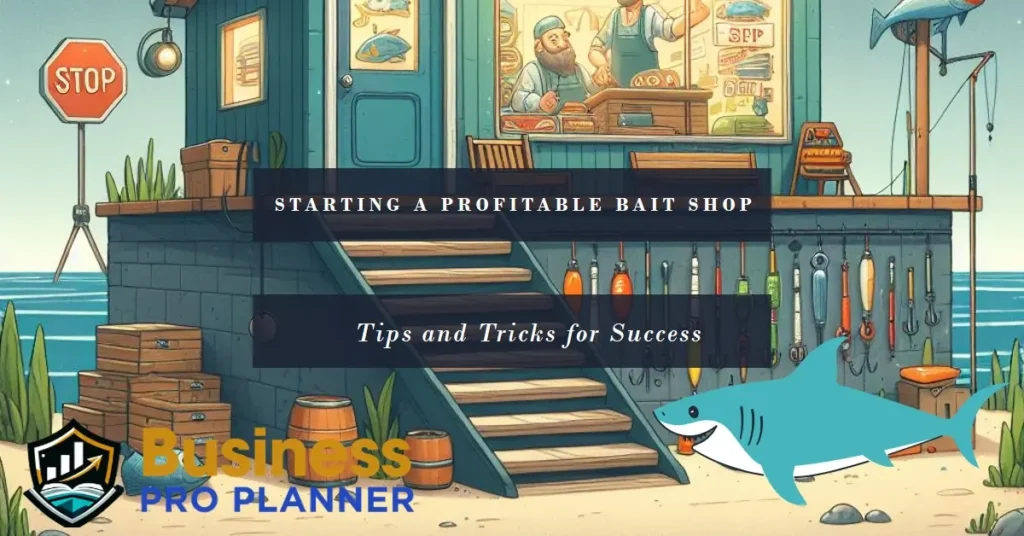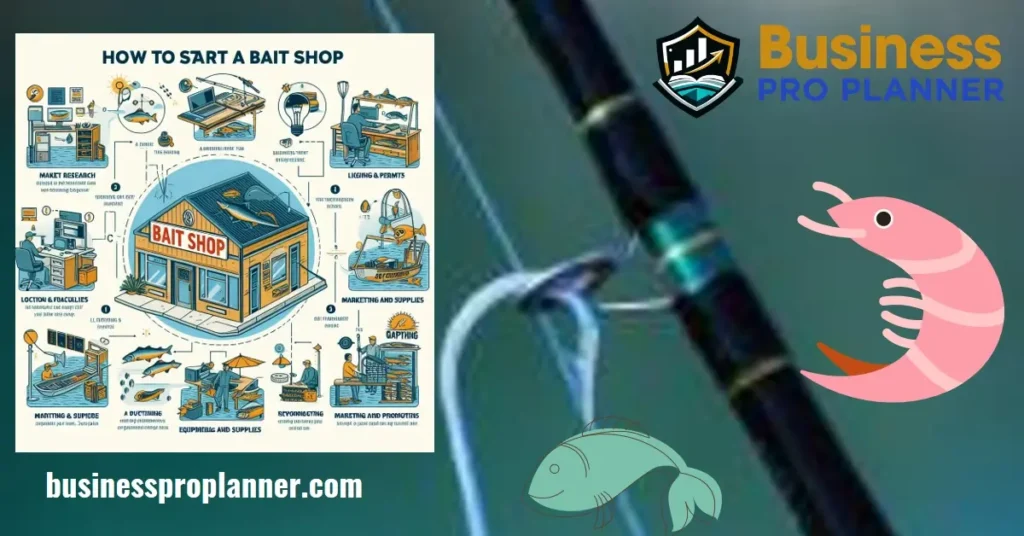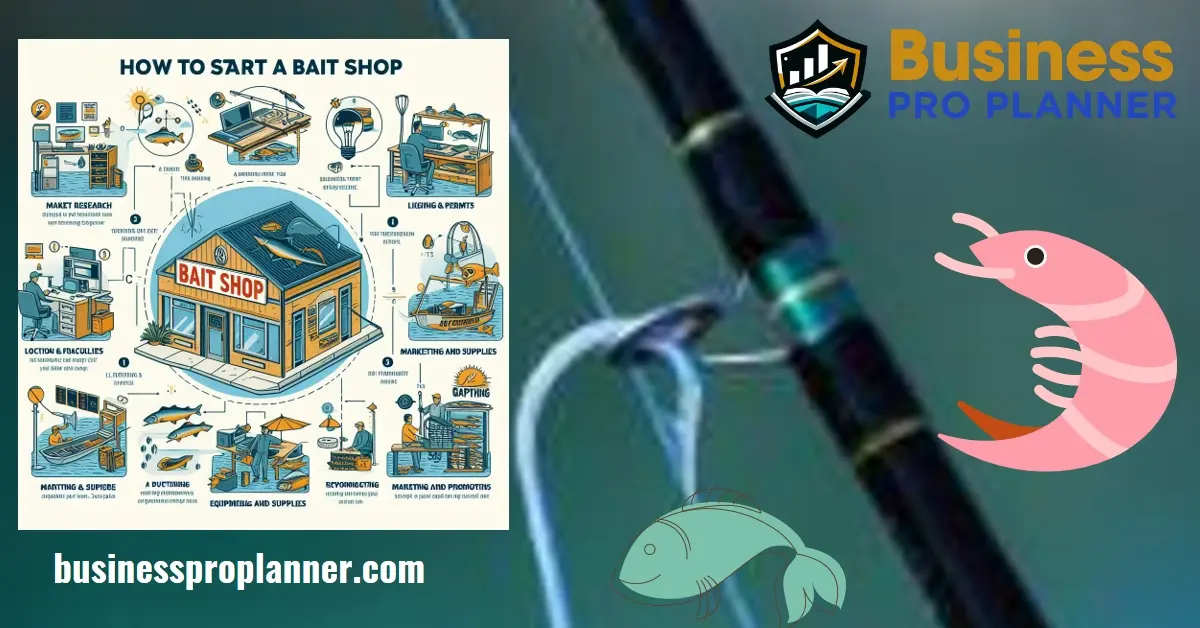Start a bait shop – Opening a bait shop can be a dream come true for avid anglers and outdoor enthusiasts. Bait shops play a vital role in local fishing communities by providing equipment, live bait, and advice to help anglers land the big catch. For many, a bait shop is the go-to place to pick up supplies and swap fish stories. Initiating a bait shop provides an opportunity to translate your passion for fishing into a viable small business endeavor.
However, a bait shop is more complex than just selling worms and minnows. You need to understand the tackle business, create a smart business plan, obtain proper licensing, stock quality gear and bait, and market to local anglers. This guide offers a detailed exploration of launching a successful bait and tackle shop, covering essential aspects comprehensively.
We will cover business basics like choosing a structure and location, projecting costs and profitability, arranging inventory, and promoting your new shop. With dedication and planning, you can start living the dream of running your hub for the area’s fishing community. Let’s begin this rewarding journey of opening up your bait shop!
Understanding the Bait and Tackle Business
The bait and tackle industry provides key products and services for recreational and commercial anglers. Bait shops play an integral role in this market.
Overview of the Bait and Tackle Industry
The bait and tackle sector generates billions in sales annually in the United States. Major products include:
- Fishing rods, reels, lures, line, hooks, sinkers, nets
- Live, frozen, and artificial baits like worms, minnows, grubs
- Boating equipment – paddles, life jackets, ropes, anchors
- Protective apparel such as hats, shirts, waders, boots
- Coolers and other storage for catches
- Snacks, beverages, and convenience items
Independent bait and tackle shops meet local demand for fishing gear and supplies. Big box retailers like Walmart also carry lower-priced equipment. Online retailers like Amazon offer convenience but local shops provide knowledge and specialty items.
The industry relies heavily on recreational fishing participation. There are over 49 million anglers in the U.S. who spend $48 billion annually on trips and equipment. They are the core bait-and-tackle customer base.
Role of Bait Shops
Local bait shops are a beloved community hub for anglers. Key roles include:
- Carrying Quality Gear & Bait: Well-stocked selection of rods, reels, lures, and especially live bait. Anglers depend on this.
- Providing Expert Advice: Staff shares local fishing knowledge like hot spots, techniques, and seasonality. Helpful for customers.
- Teaching Classes: Host educational clinics on gear, knots, fishing methods, regulations, etc. Builds skills.
- Offering Convenience: Sell fishing licenses, snacks, and other essentials for quick grab-and-go trips.
- Building Community: Bait shops are a gathering place for anglers to swap stories and tips. Fosters camaraderie.
Owning a bait shop allows you to fuel the passion of local anglers while making an income. But it also comes with work and risks, which must be weighed.
Pros and Cons of a Bait Shop
Pros:
- Do work you love as a fishing enthusiast
- Provide a valued community hub and resource
- Build relationships with customers
- Flexible lifestyle and seasonal hours
- Opportunity for all ages to run a small business
Cons:
- Significant start-up costs and overhead
- Need proper licenses and compliance
- Early mornings to acquire live bait
- Physical nature of work
- Revenue fluctuates seasonally with fishing
- Risks of low traffic and competition
Starting a bait shop is rewarding but requires research on local fishing demand, competition, regulations, and more to succeed.
Follow these Steps to Start a Profitable Bait Shop

Assessing the Business Opportunity
The first step is researching the business opportunity in your area. Here are some key questions to ask:
- Is there a demand for a new bait shop? Many bait and tackle shops thrive in regions with an active fishing community. Ensure there are enough recreational anglers to support another store.
- What do local anglers need? Talk to fishermen about gaps in equipment selection or live bait options. Find niches to fill.
- How competitive is the market? Research other tackle shops in your vicinity. Can you differentiate your offering? There may be room for another store if existing ones are far apart.
- What fishing spots are nearby? Proximity to popular fishing areas like rivers, lakes, and beaches brings in customers. Make sure ample fishing opportunities exist.
- Is a prime retail location available? Look for a spot with easy parking and road visibility to attract passing anglers. A cozy resort village and opening near marinas or boat ramps is ideal.
By scrutinizing the area, you can determine if the market can sustain another bait shop. Customers are essential, so choose a location with an enthusiastic fishing community.
Crafting a Business Plan
Once you verify demand, create a formal bait shop business plan. This is an invaluable document to sharpen your strategy and prepare for launch. Key elements to include:
- Executive Summary: Highlights your mission, competitive edge, and financial outlook.
- Company Description: Covers your shop’s legal structure, ownership team, and start-up costs.
- Products & Services: Details your merchandise selection and any live bait offerings.
- Market Analysis: Research your geographic area, target customers, and competitors.
- Marketing Strategy: Ways you will promote the shop and attract anglers.
- Financial Plan: Projected income statement, balance sheet, expenses and profitability.
- Funding Request: If needed, how much capital do you seek, and how it will be used?
Refining your bait shop’s concept on paper helps spot potential problems and opportunities early on. The business plan also shows investors you’ve done your homework.
Choosing a Business Structure
You must choose a business entity for your bait shop. Common options include:
- Sole Proprietorship: You fully own the business as an individual. Simple and inexpensive, but a personal liability.
- Partnership: Shared ownership between two or more people. Allows combining resources but adds complexity.
- LLC: Hybrid entity with liability protection for owners. More credibility than a sole proprietorship.
- S Corporation: Pass-through taxation like an LLC but with ownership via stock shares.
- C Corporation: Separate legal entity from owners to limit liability. Useful for attracting outside investors but double taxation.
Talk to an attorney or accountant to select the right structure. They can help navigate legal and tax considerations.
Registering the Business
Once you select an entity, it’s time to make it official. Key steps include:
- Choosing a Name: Pick a unique but descriptive bait shop name and check availability.
- Filing Formation Documents: Submit the required paperwork and fees to your state regulatory agency.
- Obtaining Permits/Licenses: Apply for a sales tax ID, business license, and any fishing/hunting permits needed locally.
- Setting up Accounting: Open a business bank account and establish bookkeeping practices.
Don’t skip legal registration and licensing steps. This protects you from penalties and formally establishes the bait shop.
Arranging Inventory & Equipment
Now for the fun part – filling your new store! Key considerations:
- Types of Bait: Carry popular live varieties like worms, minnows, and grubs. Freeze-dried and artificial baits also sell well.
- Fishing Gear: Stock rods, reels, lures, tackle, and accessories for all fishing methods – spinning, fly fishing, ice fishing, etc.
- Boating Supplies: Serve boaters too with items like ropes, fuel tanks, paddles, and safety equipment.
- Clothing/Footwear: Sell functional hats, shirts, waders, and waterproof boots. Essentials for anglers.
- Coolers: Display a variety of coolers and live wells. Useful for transporting bait and keeping catches fresh.
- Additional Inventory: Snacks, fishing licenses, sunglasses. Make your shop a one-stop destination.
Start with a core selection and expand over time. Buy wholesale to get discounts from major suppliers. Offer competitive prices but quality products.
Obtaining Proper Licensing
Some additional licenses and permits may be needed depending on your bait offerings:
- Commercial Fishing License: Required in most states to sell wild-caught bait like minnows, crayfish, or leeches.
- Aquaculture Permit: If you plan to breed and sell your live bait like worms or crickets.
- USDA License: For selling live species across state lines. Transporting bait triggers federal oversight.
- Refrigerated Trucking: To deliver perishable bait; requires DOT certification and inspection.
- Fishing Licenses: Sell state fishing/hunting licenses onsite for customer convenience.
Review all state and local regulations for the bait types you’ll carry. It’s crucial to have proper licenses to legally harvest, buy, and sell live bait.
Marketing Your New Business
Getting the word out is key to attracting anglers to your shop. Some promotional tactics to try:
- Grand Opening Event: Offer discounts, freebies, and a ribbon-cutting ceremony. Alert local media.
- Website: Showcase your inventory, hours, and bait selection online. Allows ordering bait ahead of time.
- Search Ads: Use Google/Facebook ads to appear when people search for “bait shop” in your area.
- Signage: Place bold, eye-catching signs with your logo on busy roads. Inform drivers you’re open for business.
- Local Partnerships: Ask nearby marinas, campgrounds, and hotels to display your brochures.
- Social Media: Share fishing tips and promote products on a store’s Facebook/Instagram account.
- Email Newsletter: Collect emails to send out weekly store updates and specials.
- Sponsorships: Sponsor kids’ fishing derbies or tournaments. Gets your brand visible.
Getting the word out about your amazing new bait shop ensures a steady stream of eager anglers.

Tips for Running a Successful Bait Shop
Once open, focus on delighting customers to build loyalty. Some areas to emphasize:
- Offer helpful, knowledgeable service. Make rookies feel welcome alongside seasoned fishermen.
- Host free educational events like knot-tying demos or fly-fishing casting lessons. Building community brings repeat visits.
- Carry the freshest, highest-quality live bait. Check stock daily and remove any dead specimens.
- Appeal to families. Add a kids’ corner with books, toys, and youth starter rod/reel combos.
- Bring in guest speakers, like Fish & Wildlife officers or professional anglers. Interesting for patrons.
- Sponsor a community fishing team. Gets families invested in your shop’s success.
- Share favorite local catches on social media. Lets you constantly market.
- Maintain an updated website with current inventory, classes, and bait availability.
Meeting customers’ needs, creating a friendly vibe, and stocking top-notch bait are the keys to bait shop prosperity.
Final Thoughts
Opening your own bait and tackle shop is an ambitious but rewarding undertaking. The process demands significant planning, start-up funds, and a real passion for fishing. By committing yourself fully, securing a strategic location, and promoting your store creatively, you can provide the equipment and bait local anglers need while turning a healthy profit. Just take things one step at a time. Before you know it, you’ll be a proud bait shop owner serving happy customers and bringing in sales.

